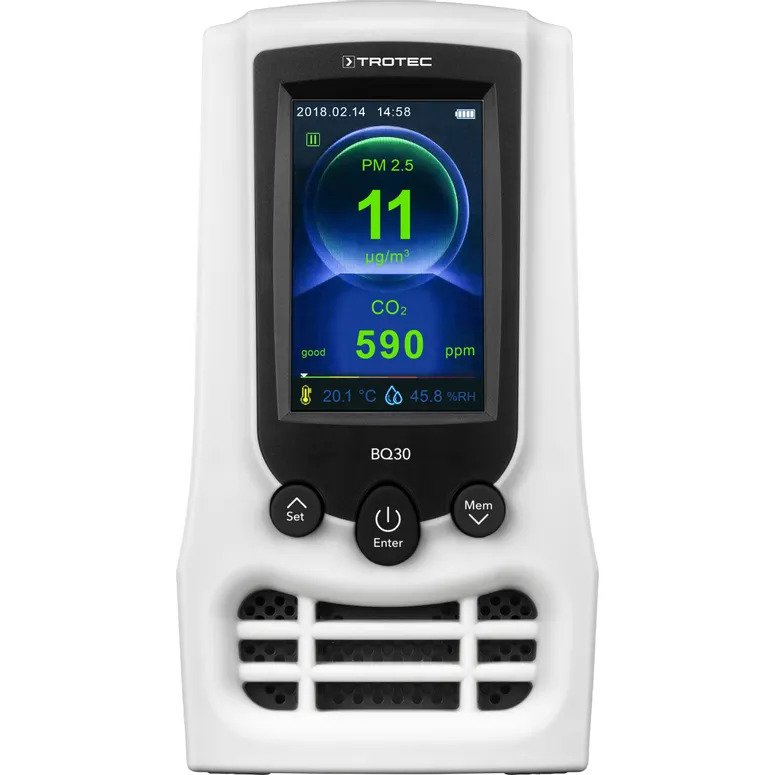Trotec BQ30 CO2 Air Quality Monitor and Particle Measuring Device


Trotec BQ30 CO2 Air Quality Monitor and Particle Measuring Device
| Product Code: J6650 |
Trotec BQ30 CO2 Air Quality Monitor and Particle Measuring Device
The Environmental Protection Agencies of Australia and the USA both recognise that we spend more than 90% of our lives indoors, and are thus mainly exposed to indoor air. In addition, the increasingly dense and enclosed energy efficient building designs and standards of western nations makes it difficult to vent pollutants to the outside. This brings noticeable effects to our air quality and makes occupational and/or dwelling safety an issue.
Elevated carbon dioxide concentrations - even if they are within the permissible limits - can not only lead to fatigue, poor concentration or loss of performance, but can also cause serious health problems, especially in children or vulnerable individuals.
With the BQ30, indoor air quality can be reliably monitored and, comparable to a CO2 traffic light, helps to remember to ventilate.
Thanks to precise sensors, the BQ30 records not only air temperature and relative humidity but also the current carbon dioxide concentration of the room air. It shows this in 1 ppm steps upon the easy-to-read display.
In addition, an individual CO₂ alarm limit value can be defined, which is indicated by an acoustic warning signal when exceeded.
Air quality monitor and particle measurement in one device
Nowadays, the discussion about particulate matter in the air and its effects on health is unavoidable. But what makes particulate matter so dangerous? The standard convention of measurement distinguishes between the two particle fractions PM10 and PM2.5.
PM10 includes all particles with a maximum diameter of 10 µm, and PM2.5 includes all particles with a diameter smaller than 2.5 µm. These particles cannot be seen with the naked eye. They are so small that (especially the particles of the size PM2.5) they can penetrate into the alveoli. of the lungs and enter the human (and other animals) bloodstream, with possible significant health effects. Smaller particles of sub - 1 µm in size are even capable of penetrating organs and the blood brain barrier, where it may wreak havoc.
In everyday life, we are surrounded by countless potential sources of particulate matter. Whether you live or work on a busy street or near an industrial area, it is likely that the level of particulate matter in the air you breathe is elevated. In addition, in rooms and buildings where many people are present, the CO₂ content often increases above average.
Habitual activities such as cooking, vacuum cleaning, tobacco and candle smoke, or emissions from heating sources such as stoves or fireplaces can also have a direct negative impact on the indoor climate, and thus on well-being. This is because an increased concentration of fine dust as well as the CO2 content in the air can not only influence general well-being, but can also be responsible for concentration and sleep disturbances, and also a wide variety of allergic reactions. In the long term, fine dust increases the risk of cardiovascular and respiratory diseases and even lung and other cancers.
With the practical particle meter BQ30, you always keep an eye on the values for fine dust, CO₂, air temperature and humidity. And as mentioned, comparable to a CO2 traffic light, you can react, if necessary, to improve the indoor climate by either supplying fresh air or by effectively using air purifiers, humidifiers or dehumidifiers.
Keep an eye on the concentration of house and fine dust, soot and pollen
The user-friendly mobile air quality monitor detects and quantifies the mass concentrations of fine dust particles of all kinds. The measuring device easily detects the smallest air impurities of the sizes PM2.5 and PM10 in micrograms per cubic meter, via advanced laser technology.
The BQ30 also enables effective long-term monitoring of particle pollution via adjustable, regular time intervals. Up to 5,000 data records can be stored, in which both the PM concentrations and the date of recording are registered. This data variety is optionally displayed clearly in graphical curve progressions on a large 3-inch color display.
With regard to the mass concentrations of the particle size PM2.5, predefined limit values can be defined for the BQ30, the exceeding of which is signaled by an acoustic alarm. In addition, six-stage color indicator displays with respective alarm levels help to quickly evaluate whether the particle concentrations are to be assessed as good to very critical.
All-round measuring instrument for indoor climate monitoring
The handy all-round measuring device also simultaneously records other health-relevant indoor climate parameters with its probes: such as the CO₂ load in ppm, the air temperature from -20 to 70 °C and the humidity from 0 to 100 % r. h. The measured values for PM10 as well as CO₂ are shown in an automatically changing display on the display. A further three-stage color indicator completes the user-friendly visualization of these two parameters in particular in relation to good to poor air quality.
The Importance of Humidity in the Indoor Environment
Humidity levels can be particularly handy to know, since at a certain level of humidity there is a significant increase in the ability of mould(mold) spores to form on vulnerable surfaces, which could lead to an outbreak of fungal organism growth on surfaces, with further potential adverse health consequences.
Due to its precise measurement results, its cordless, enduring battery operation, its low weight and its compact dimensions, the BQ30 air quality monitor is the perfect companion wherever evidence of a possible health hazard due to fine dust and CO₂ pollution is required.
Automatic Baseline Calibration
The expected CO2 fresh air value today is about 400 ppm (0.04 %vol). This is assumed by the instrument as the lowest limit value (baseline). A special algorithm now permanently monitors the lowest detected CO2 reading of the sensor over a pre-configured time interval for several days and slowly corrects any detected long-term drift compared to the expected fresh air value of 400 ppm (or 0.04%vol) CO2. In normal indoor applications, this will cause the carbon dioxide level to drop to near outdoor air levels at some point over the course of a week. By recording the values over an 8-day period and then comparing the lowest value to the 400 ppm point, the meter detects whether or not it needs to adjust the zero point. This is done completely automatically. The algorithm thus takes advantage of the fact that the CO2 content in buildings/rooms regularly stabilizes to a minimum for a certain period of time when they are not occupied. In rooms that are permanently occupied or in which there is a constantly increased CO2 concentration (e.g. greenhouses), this principle of automatic adjustment therefore does not work.
Advantages for practice:
Long-term air quality monitor for simultaneous measurement of the particle mass concentration in the air
Fine dust measurement with max. diameter of PM2.5 and PM10
Display of CO2 load, current room temperature and room humidity, comparable to a CO2 traffic light
Memory for up to 5,000 data sets
Bar graph indicator display
Additional color indicator display with automatic acoustic alarm for fast detection of critical particle concentrations
Automatic switch-off
3-inch color display for simultaneous display of all measured parameters
Battery and mains operation possible
Adjustable screen brightness
Automatically changing display of all measured climate parameters
Date and time display
Language selection
Battery status display
Technical details:
Detectable particle sizes: 2.5, 10 μm
Measuring range mass concentration (PM 2.5): 0 ~ 2000 μg / m³
Measuring range mass concentration (PM 10): 0 ~ 2000 μg / m³
Measuring range temperature: -20 - 70 °C / -4 - 158 °F
Measuring range rel. humidity: 0 - 100 % r.h.
Battery type: 7.2 V Li-ion
Dimensions: 211 x 141 x 86 mm
Weight: 233 g
| Height | 22.000000 |
| Width | 15.000000 |
| Length | 10.000000 |
| Weight | 0.600000 |
This product has no reviews.






